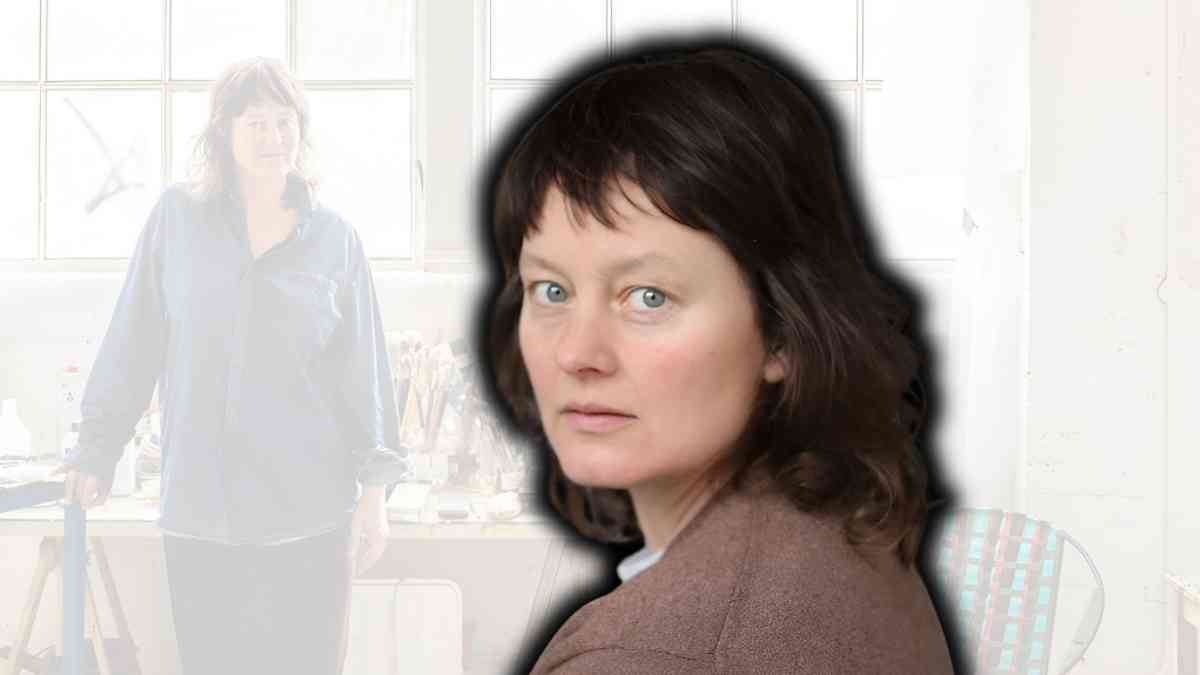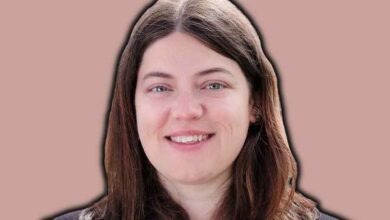Caragh Thuring: The Painter Reconstructing the Language of Visual Memory

Caragh Thuring is one of the most distinctive voices in contemporary British art. Known for her unconventional methods and symbolic compositions, she has carved out a unique space where industrial motifs, natural elements and personal memory blend into captivating visual narratives. Her art does not conform to the expected conventions of figurative or abstract painting; instead, it floats somewhere in between, inviting viewers to engage in a personal and psychological dialogue.
Born in Brussels in 1972 and raised in the United Kingdom, Thuring’s multicultural background and exposure to diverse landscapes have greatly influenced her work. From looming volcanoes to tartan patterns and architectural fragments, she draws from eclectic sources to craft a visual language that is both deeply personal and strikingly universal.
Early Life and Background
Although born outside Britain, Thuring moved to the UK in her early childhood. Her upbringing and education in England, including her formal training at Nottingham Trent University, laid the foundation for her career in visual arts. Unlike many of her contemporaries, Thuring did not begin her journey with a set formula. She avoids preliminary sketches or rigid planning, preferring to confront the canvas directly. This immediacy allows for spontaneity, making her art feel alive and in flux.
Her Scottish and Belgian roots often surface in her choice of symbols and visual texture. Whether it’s a memory of a Scottish glen or an industrial site from continental Europe, her work echoes both heritage and innovation.
Artistic Style and Influences
Thuring’s artistic style defies categorisation. One of the most notable aspects of her work is her tendency to paint directly onto bare linen or woven fabric. This decision is not merely aesthetic; it represents a conceptual bridge between surface and subject. She often commissions woven images of her previous works and paints over them, effectively blurring the boundaries between original and reproduction.
Recurring motifs populate her paintings: volcanoes symbolise latent energy; brickwork speaks to urban rigidity and memory; and tartan patterns, linked to her Scottish heritage, provide a visual rhythm. Architecture plays a key role in her compositions too, often depicted with a cold precision that echoes Brutalist and post-industrial design.
Despite these repeated forms, Thuring’s art is not didactic. She offers no clear narratives. Instead, she uses familiar elements to construct ambiguous spaces that allow multiple interpretations. Her canvases become memory palaces—spaces where the viewer must assemble meaning from fragments.
Notable Exhibitions and Recognition
Over the past two decades, Thuring has become a regular fixture in respected galleries and museums across the UK and beyond. Her solo exhibitions have taken place at the Thomas Dane Gallery in London and Naples, Chisenhale Gallery in London, and Anthony Meier Fine Arts in San Francisco.
Her work has also been showcased in group exhibitions at the Royal Academy Summer Exhibition, Tate St Ives, and the Hayward Gallery. These shows not only validated her work among peers but also exposed her unique vision to a broader audience.
In 2024, she achieved a significant milestone by being elected as a Royal Academician in Painting by the Royal Academy of Arts. This honour cements her status as one of the foremost painters working in Britain today.
Materials and Mediums
What sets Thuring apart is not just what she paints but how she paints. Her use of materials is deeply intentional. The choice to paint directly on to linen or to incorporate woven reproductions of her work invites a conversation about authenticity and repetition. She disrupts the traditional notion of canvas as a neutral space, making it an active participant in the storytelling process.
This blending of painting and textile points to the interconnectedness of craft and fine art. The artist herself has spoken about the importance of process and how the act of weaving, painting and layering becomes a meditative engagement with memory and materiality.
Symbolism and Recurring Themes
Caragh Thuring’s art is not simply about what is seen but about what is remembered. Her motifs—volcanoes, bricks, submarines, tartans—form a symbolic lexicon. These elements reappear across her works, not as repetitions but as re-contextualised icons.
Volcanoes, for example, are not just geological features but metaphors for dormant energy, emotional pressure or cultural upheaval. Tartan patterns bring in questions of identity, family lineage and historical continuity. The presence of submarines or industrial buildings hints at the legacy of technological advancement and its psychological aftermath.
Rather than telling a story outright, these symbols serve as triggers. They suggest rather than dictate. Viewers are invited to connect the dots, to let their personal histories interact with the artist’s layered compositions.
Public Commissions and Permanent Collections
Caragh Thuring’s reach extends beyond gallery walls. Her works are featured in several major collections including the Tate, Arts Council Collection, Government Art Collection, and Buffalo AKG Art Museum in the United States.
Her public commissions are equally impactful. “Great Things Lie Ahead,” a striking mural in London’s Holborn House created in collaboration with 6a Architects, demonstrates her ability to integrate fine art with public space. Another piece, “Eruzione del 2020,” located in Positano, Italy, underscores her growing international recognition.
Such projects not only highlight her versatility but also her commitment to engaging with the public in new, thoughtful ways. They prove that her visual language can translate across contexts, from the intimacy of a gallery to the expanse of urban architecture.
Intellectual and Conceptual Depth
Thuring’s work is rich with conceptual inquiry. She often engages with ideas around the reproduction of images, the fragility of memory, and the tension between structure and chaos. By layering painted surfaces over woven reproductions of her earlier works, she turns the canvas into a site of conflict and reconciliation.
There’s also a philosophical undercurrent in her method. Painting, for Thuring, is not just an act of expression—it’s a way of thinking, of piecing together fragments of the self and the world. Her process is both intuitive and intellectual, spontaneous and rigorous. This duality adds a powerful dimension to her art, making it resonate on multiple levels.
Recent Work and Continuing Legacy
In recent years, Thuring has continued to evolve her practice. In 2023, her exhibition “The Foothills of Pleasure” at Thomas Dane Gallery introduced smaller-scale works based on Mount Tamalpais, a Californian mountain she never visited in person. Working solely from reference material, Thuring challenged the idea of presence in landscape painting, questioning whether physical interaction is necessary for emotional or aesthetic engagement.
Her monograph, Very Fantastically Arranged, published by MIT Press, provides further insight into her career, process, and visual vocabulary. It stands as both a retrospective and a tool for deeper understanding of her multi-layered approach.
Conclusion
Caragh Thuring stands as a profound and essential figure in British contemporary painting. With her innovative methods, symbolic depth and bold disregard for traditional boundaries, she offers a refreshing counterpoint to formulaic visual art. Her paintings are not easy—they demand attention, interpretation, and reflection. But in return, they offer a rich and layered experience that lingers in the viewer’s mind long after the first glance.



